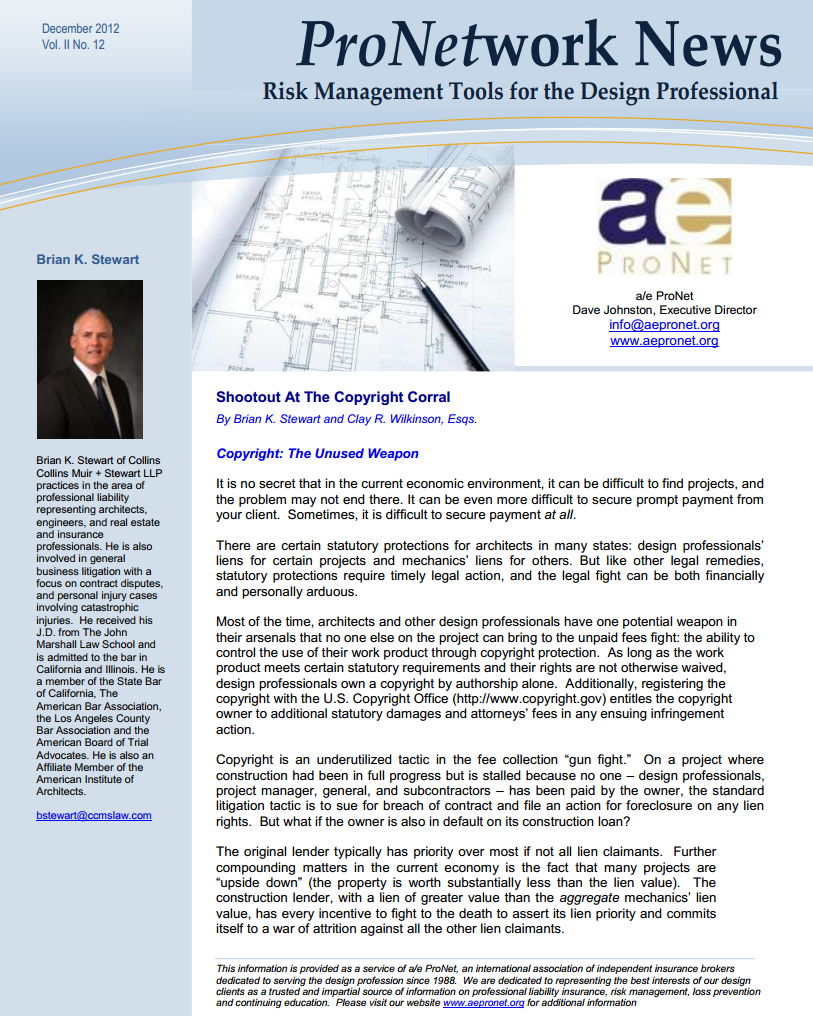One of the many value added resources a/e ProNet brokers offer is access to our ProNet Practice Notes, in-depth white papers prepared by members of a wide variety of professions related to the design industry. They offer insight and advice on topics like risk management, practice management, and litigation issues for Architects, Engineers, and other Design Professionals.

Our most recent edition is titled The Collections-Claim Connection: Getting Paid Without Getting Sued, authored by attorney David A. Ericksen of Severson & Werson in San Francisco, CA. The full PDF version of this excellent paper, including several helpful attachments, is available for download at our website. The following is an excerpt for your review. We hope you find it helpful!
Introduction
While money isn’t everything, it is the measure and fuel of any business, including a design firm. Without payment for services firms suffer, starve, and even die. Payment issues are also often the single greatest warning sign of a project in trouble.
Perhaps there is no greater indicator of the correlation between unpaid fees and troubled projects and relationships than the remarkable frequency with which efforts of design professionals to collect unpaid fees through litigation result in even larger responsive counter-claims from clients alleging professional negligence. 2011 gave the entire industry the most dramatic and alarming example of this pattern. Having already received over $8.2M in fees, the engineering firm Carter & Burgess sued its client the City of Victorville in Southern California for the final $106,196 on a power plant project that the City had been forced to partially abandon mid-project due to cost overruns. The City responded with a counter-claim for professional negligence. When the verdict came in 2011, it was devastating financially and professionally as news, industry, and internet sources widely reported and publicized the award of $52.1M in damages against the engineering firm.
The results of such a counter-claim need not be as dramatic in terms of publicity or financial losses to be devastating to the firm. In addition to the unpaid fees, there are many other impacts of even a “defensive” counter-claim. They frequently include:
- Deductible payments for legal fees and costs, which may even include the involvement of a second “defense” attorney.
- Insurance impacts for rating, pricing, and loss history.
- Lost internal time and resources for purposes of participation in defense.
- Publicity and required disclosures in future responses to RFPs for claims history.
- Potential uninsured exposure for prevailing party attorneys’ fees if negligence claims exceed fee claims.
- Ultimate discounted or waived fees for expediency of resolving and closing claim.
Obviously, avoiding such collection challenges and the potential for responsive claims is critical to good business and project success.
In reality, a proper approach to collections closely resembles a proper regimen for personal health. Firms which get paid become and remain healthy and strong. Firms which do not get paid regularly and on time become malnourished and increasingly susceptible to disease. Just as health is a life-long process, financial success is a project-long process. The following discussion tracks the relevant phases and provides analyses and strategies for those various phases. Those phases are: Continue reading “{ProNet Practice Note} The Collections-Claim Connection: Getting Paid Without Getting Sued”
 Design firms go through their Professional Liability insurance renewals annually. Did you know the insurance companies actually get reviewed annually, too?
Design firms go through their Professional Liability insurance renewals annually. Did you know the insurance companies actually get reviewed annually, too?




